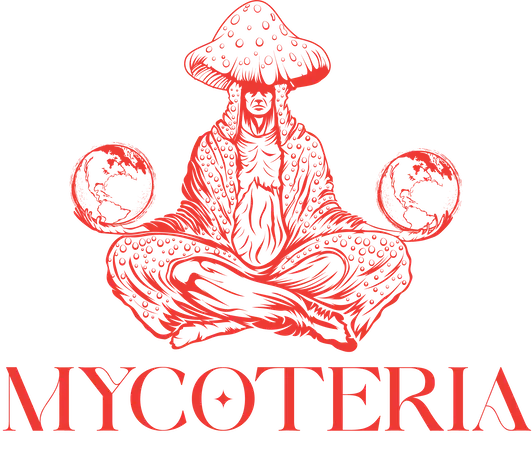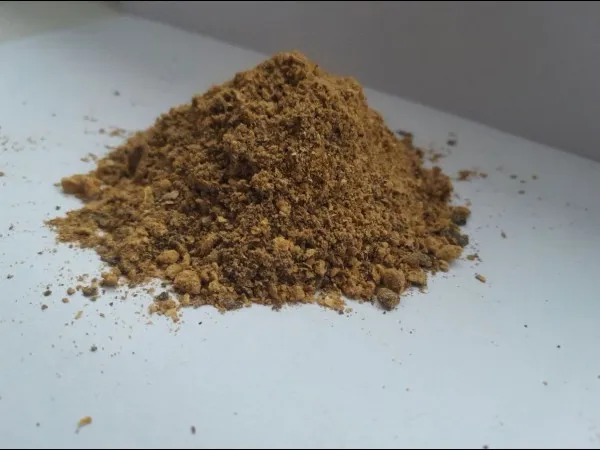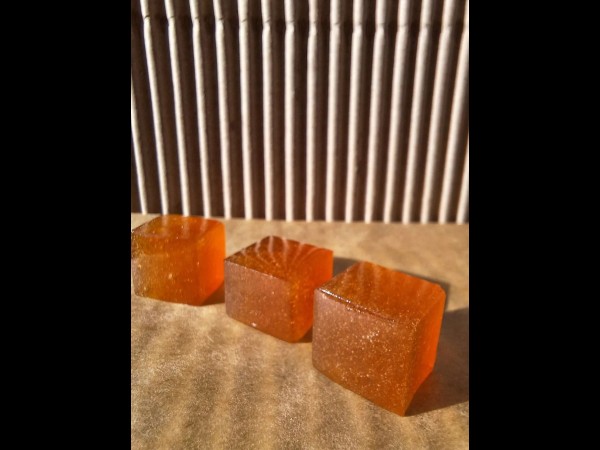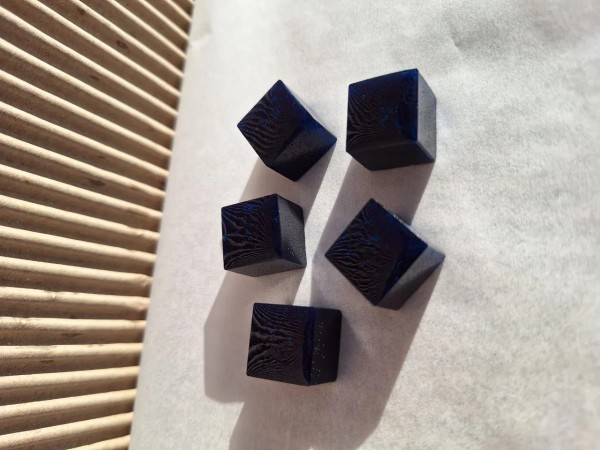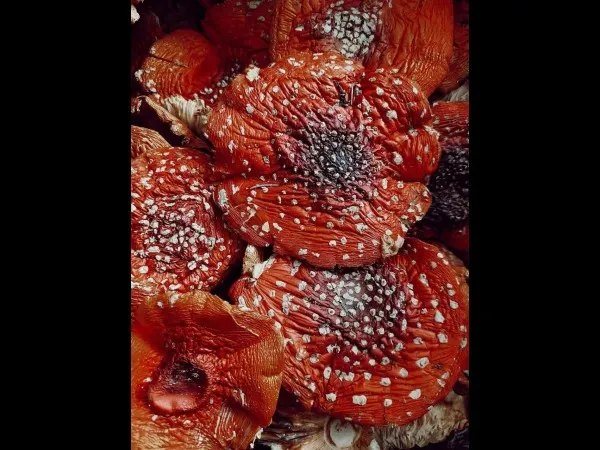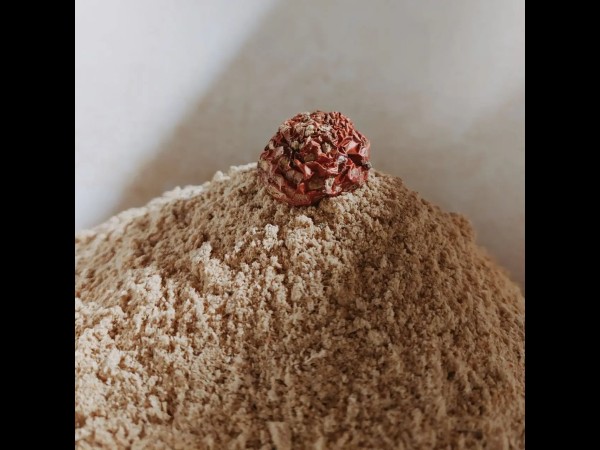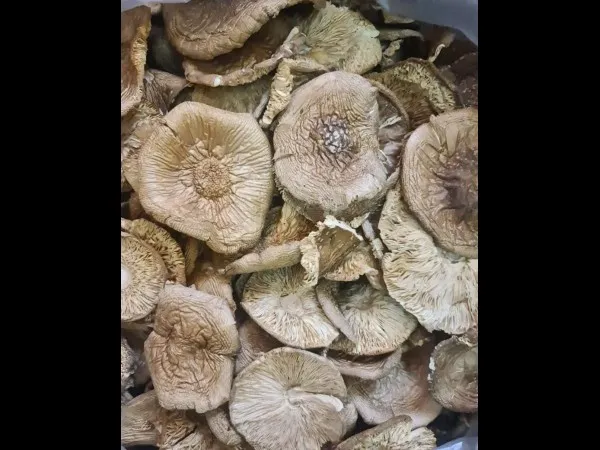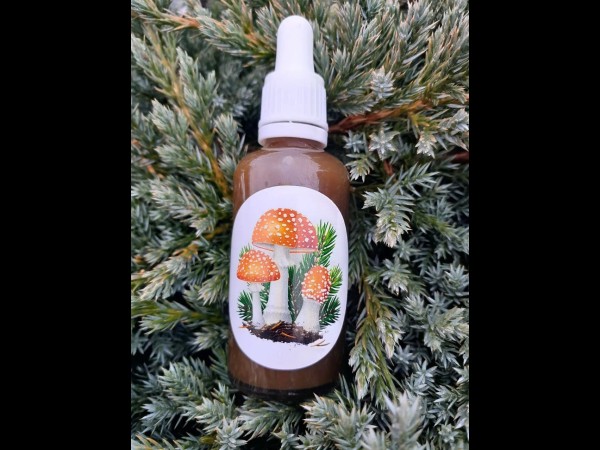- today
- perm_identity Mycoteria.com

Disclaimer
The statements made regarding Amanita Muscaria products have not been approved by the Food and Drug Administration (FDA) as a consumable food. Amanita Muscaria products are not intended to diagnose, treat, cure, or prevent any disease. The information provided is not intended to be a substitute for professional medical advice, diagnosis, or treatment.
Amanita Muscaria's effects are the reaction one might feel after consuming this beautiful red and white colored mushroom in any form. Since the Amanita Muscaria mushroom contains psychoactive substances like muscimol and ibotenic acid which interact with our brain, a person can feel euphoric, and hallucinative effects alongside the medical benefits of the Amanita mushroom. Let’s dive deeper into the effects of the mystical Amanita further in the article.
What are the compounds of Amanita Muscaria?
The mushroom of Amanita Muscaria contains 2 main compounds that are psychoactive: ibotenic acid, and muscimol, and the third non-psychoactive ingredient muscarine. Ibotenic acid and muscimol are structurally similar to GABA and they act as neurotransmitters in the central nervous system. Muscimol is the main psychoactive ingredient in Fly Agaric. Comprehending the chemistry underlying Fly Agaric (Amanita Muscaria) mushrooms is essential to appreciating their possible effects on those who consume them.
Muscimol
Muscimol is the main psychoactive compound in Amanita mushrooms. It acts as a potent agonist of the GABAa neurotransmitter receptor in the brain and enhances the activity of the neurotransmitter GABA. Since muscimol is classified as a deliriant, it has the ability to produce hallucinations and other altered states of consciousness. Muscimol will produce different dosage-dependent effects like a change of mind state, but won’t be overwhelmingly psychedelic like traditional “magic mushrooms”.
Despite the psychedelic-like effects, muscimol has plenty of potential for medicinal uses and mind-altering experiences. This compound is involved in the regulation of mood, anxiety, sleep, and brain function.
Ibotenic acid
Ibotenic acid is largely related to muscimol as it is the precursor to muscimol. When Amanita Muscaria mushrooms are ingested or dried, the ibotenic acid they contain is decarboxylated forming muscimol. This decarboxylation process is usually initiated by drying, heat, or the acidic environment of the stomach. Ibotenic acid activates glutamate NMDA receptors which can provide enhanced neural plasticity, learning, and memory.
Due to its toxic nature, ibotenic acid is not used medically, and overstimulation from ingesting a large amount of ibotenic acid can result in confusion, delirium, gastrointestinal distress, sleepiness, and ataxia. Normally these symptoms will decline as the compound is converted to muscimol in the body. In best cases, this conversion should happen before ingestion, through processing methods.
Muscarine
For some time, muscarine was believed to be the psychoactive alkaloid of the Fly Agaric, however, in 1964 researchers in Japan, England, and Switzerland isolated ibotenic acid and muscimol while discovering their psychoactive properties. Muscarine alone is the alkaloid responsible for the feeling of intoxication – discomfort, upset stomach, and nausea.
The quantity and proportion of alkaloids contained in the Amanita Muscaria mushroom depend on several factors. Most importantly, mushrooms collected at higher altitudes have higher concentrations of ibotenic acid/muscimol, whereas those collected at lower altitudes contain more muscarine.
Amanita Muscaria effects
Ibotenic acid and muscimol both produce psychedelic effects. When taken via ingestion, the effects take a while to show up and start to come on 30 to 90 minutes after ingestion, often taking 2 to 3 hours to reach their peak. Depending on the dosage, the effects last for approximately 6 to 8 hours. The effects' characteristics might vary greatly, depending on individual variances, diversity, and dosage.
The high described from eating Amanita muscaria is different from the high caused by psilocybin. Once the effects of Amanita Muscaria start to appear, people report strong visions and religious insights. However, they often occur once the user has fallen asleep, where the user sees these visions and gets lessons in the dreams. What is more, after consuming Fly Agaric people report dream-like sensations, and describe the high as “strange.”
In addition, users describe experiencing looping encounters when they find themselves repeating actions during an Amanita Muscaria trip. This could be due to the mushroom's deliriant properties, which can cause delusions where people can't discern what's genuine from what isn't.
Other occurring effects of Amanita Muscaria mushroom consumption are stated below.
- Stimulation, increased energy, and sometimes muscular vitality.
- A decay, tranquility, and drowsiness.
- The appearance of psychedelic effects, possible experiences of a mystical nature, awareness of non-ordinary realities, and blissful or even scary sensations.
- Visual distortions.
- Loss of balance.
- Muscle spasms.
- Experiences of a dream-like nature.
- Dizziness.
- Visual and auditory impairment.
- Difficulty concentrating on external tasks.
- Sensation of perceiving objects as either very large or very small.
- Nausea and vomiting.
User reports of Amanita Muscaria vary greatly – some claim no experience at all, while others report significant trips that left them with a ton of unanswered questions the following morning. While some users claim euphoric feelings, others describe them as feeling ill and afraid. Most could agree that it is unpredictable.
How do the effects vary between Amanita Muscaria and Amanita Pantherina?
Both Amanita Muscaria and Amanita Phanterina contain the same compounds of ibotenic acid and muscimol. The difference is that each species contains these active ingredients in different concentrations, therefore the intoxication is also different. Amanita Muscaria contains more excitatory ibotenic acid and less of the depressant muscimol compared to Amanita Pantherina. That is the reason why poisonings with Amanita Muscaria mushroom present with more confusion and agitation compared to poisonings with Amanita Pantherina.
Amanita Muscaria vs. Psilocybin mushrooms
Even though Fly Agaric mushrooms are psychoactive, they differ from traditional magic mushrooms. Amanita Muscaria and Psilocybin mushrooms differ in their active ingredients, psychoactive effects, legal status, and more. Further, we describe the differences between Amanita Muscaria and Psilocybin mushrooms.
Active ingredients
Mushrooms containing psilocybin, commonly known as “magic mushrooms” or “shrooms,” are fungi that contain the psychoactive compound psilocybin. Psilocybin is a naturally occurring psychedelic agent, which, when ingested, turns into psilocin and can produce powerful visualizations and mystical experiences. Psilocybin mushrooms are one of the most popular and widely used magic mushrooms in the U.S. and Europe, with a history in spiritual and religious rituals.
Since psilocybin is known as a prodrug, it has to be digested by the body in order to start acting. Therefore, when people ingest magic mushrooms, psilocybin is broken down by the liver through a process called dephosphorylation, which turns it into the bioactive form known as psilocin. Both psilocybin and psilocin are hallucinogenic, although the majority of the psychedelic effects of magic mushrooms are attributed to the compound psilocin.
Amanita Muscaria mushrooms contain the previously described muscimol, ibotenic acid, and muscarine as the main active compounds. Therefore, magic mushrooms and Fly Agaric contain completely different compounds.
Psychoactive effects
When it comes to the effects, Amanita Muscaria's effects on humans are considered a “deliriant” rather than “psychedelic” because they don’t act on the same receptors as psilocybin or psilocin (which are considered psychedelic). Instead, Fly Agaric acts mostly on receptors that can cause an ethereal, dreamlike, or sedative state.
When compared to psilocybin, muscimol studies focus greatly on pain relief, sleep, and relaxation, while psilocybin studies focus on its abilities to help with mental and emotional conditions such as depression, PTSD, addiction, and others.
Legal status
When it comes to legality, psilocybin mushrooms are decriminalized or legalized in some states of the U.S. and countries of the world. However, they are still categorized as controlled substances in the U.S., making them illegal at the federal level.
Amanita Muscaria mushrooms, on the other hand, are legal in most places around the world. The active compounds these mushrooms contain are largely unregulated and do not exist on the DEA’s drug scheduling list, making Amanita Muscaria federally legal in the U.S. as well as most other countries of the world. The FDA has not approved A. Muscaria for human consumption, but all states of the U.S. allow sales except Louisiana.
Is Amanita Muscaria poisonous?
Due to the fact that Amanita mushrooms contain psychoactive alkaloids of muscarine, ibotenic acid, and muscimol, it is a highly poisonous mushroom. Ibotenic acid and muscimol are structurally similar to GABA and they act as neurotransmitters in the CNS, stimulating glutamate receptors. After ingestion, ibotenic acid and muscimol are absorbed and then ibotenic acid is rapidly decarboxylated to muscimol, which appears to be the agent responsible for the majority of Amanita Muscaria caused symptoms. The change between muscimol and ibotenic acid is responsible for the fluctuation in CNS symptoms.
Although poisonous, death due to poisoning from Amanita Muscaria ingestion is quite rare. Parboiling the mushroom twice with water draining weakens its toxicity and breaks down the mushroom's psychoactive substances. This helps in making the mushroom less or not poisonous at all.
Amanita Muscaria side effects
Even if it is argued that the Amanita Muscaria mushroom has been unfairly painted as the picture of pure poison, there still are some negative effects that may occur when eating it.
The majority of the compound in fresh Amanita Muscaria mushroom specimens is ibotenic acid. The cap tissue of the Fly Agaric contains an ibotenic acid to muscimol ratio of roughly 9 to 1. Even though the ratio is less in dried products, ibotenic acid frequently outperforms muscimol at a three-to-two ratio.
When consuming excessive amounts of Amanita Muscara, negative effects, such as sweating, nausea, cramps, loss of balance, involuntary bodily movements, or delirium may occur. Luckily, muscimol to ibotenic acid ratios of 90:1 or more can be produced during manufacturing operations, which lessens the harsh effects of ibotenic acid. For this reason, it is always best to choose lab-tested, processed products, like dried Amanitas, extracts, tinctures, or Fly Agaric gummies.
Amanita Muscaria poisoning
When consumed wrongly Amanita Muscaria can be poisonous and cause serious health risks. Symptoms of poisoning after consumption start 30 minutes to 2 hours after ingestion and the first effects usually involve CNS manifestations, often alternating between stimulation and depression. The first symptoms begin as a state of confusion, dizziness, agitation, ataxia, visual and auditory perceptual changes, space distortion, and a lack of awareness of time. What is more, tachycardia, bradycardia, and hypertension may also occur as well as hypothermia and hyperthermia. In severe cases of Fly Agaric poisoning, symptoms may manifest with coma and in extremely rare cases lead to death. Patients poisoned with Amanita mushrooms are treated in a hospital. Gastric lavage and symptomatic treatment should be carried out as soon as possible.
It is highly important to correctly identify the mushroom before consumption. The mortality due to Fly Agaric poisoning depends on the amount of mushroom ingested and on symptomatic/supportive therapy management.
Conclusion
In summary, it is important to note that the effects of Amanita Muscaria mushroom can vary greatly from one person to another due to factors like dosage and personal sensitivity. Compounds from Amanita Muscaria are known to induce intense psychic experiences that have historically been both admired and feared.
When it comes to choosing safe consumption of Amanita Muscaria mushrooms, it is best to buy them from trusted sources. If you are looking to delve further into the world of Amanitas, we suggest selecting dried Amanita mushroom caps, Fly Agaric tincture, Amanita Muscaria gummies, A. Muscaria extract, and more at MyCoteria store.
Continue reading
- Looking for more insights regarding Amanita Muscaria's legality? Find all about it in our blog “Is Amanita Muscaria Legal? Worldwide Legal Status Overview”.
- Fly Agaric is not only known for its effects but also for the medical benefits. Read the blog article “What are Amanita Muscaria's medical uses?” regarding the mushrooms benefits.
FAQ
What are Amanita Muscaria gummies effects?
The effects of Amanita gummies are the same as the effects of consuming other forms of Amanita mushroom due to the same active compounds. When consuming Amanita Muscaria gummies, however, it is usually easier to dose them as the gummies are all premade containing equal portions on muscimol. Amanita Muscaria extract effects are also similar to the effects or Amanita products.
What dosage of Amanita Muscaria should be taken for various effects?
The concentrations of ibotenic acid and muscimol compounds are highly variable depending on the height and specific ecosystem where the Amanita Muscaria mushroom grows, so the dosage is really difficult to determine and only the orientative doses can be indicated:
Low dose: a small or medium size Fly Agaric cap.
Medium dose: from 1 to 3 medium-sized Fly Agaric caps.
High dose: 2 or more medium-sized Fly Agaric caps.
Keep in mind, that when in the unknown of the mushroom, it is best to start with lower doses and regulate how the body feels.
How to consume Amanita Muscaria?
When it comes to consuming Amanitas, it is the safest to consume then dried or in other professionally made forms, such as extracts or tinctures. Highly avoid consuming fresh Amanitas as boiling and drying the mushroom is crucial for the poisonous active compounds to subordinate.
Is muscimol a psychedelic compound?
No, muscimol is a potent and selective orthosteric agonist for the GABA receptors. Even though it displays sedative-hypnotic, depressant, and hallucinogenic properties, it is not considered psychedelic but rather a deliriant.
Why Amanitas are also called Fly Agaric?
The name comes from old beliefs that if Amanita mushrooms were placed in milk it could kill flies.
What to do in case of poisoning due to Amanita mushrooms?
It is important to act quickly. If a person eats a dangerous amount of Amanitas resulting in poisoning, getting help right away is critical. The first symptoms of Fly Agaric poisoning are confusion, dizziness, agitation, ataxia, visual and auditory perceptual changes, space distortion, and a lack of awareness of time
Resources
- “The Deceptive Mushroom: Accidental Amanita muscaria Poisoning”(2021).
- A Method to Quantify Drosophila Behavioral Activities Induced by GABAA Agonist Muscimol (2021)
- Reasons, Form of Ingestion and Side Effects Associated with Consumption of Amanita muscaria (2023)
Related products
Delivery time:
European Union – 1 week
USA / Canada 8 – 14 days
Other 12 – 21 days
Delivery time:
European Union – 1 week
USA / Canada 8 – 14 days
Other 12 – 21 days
Delivery time:
European Union – 1 week
USA / Canada 8 – 14 days
Other 12 – 21 days




